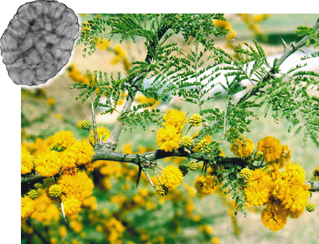|
NOSEMA: An invisible illness. Its monitoring importance.
Lic. Edgarlo Gabriel Sarlo.
Mar del Plata. Buenos Aires. Argentina
egsarlo@mdp.edu.ar
Nosema is an illness caused by a parasite called Nosema apis, which is invisible for us due to its size and symtoms, up to the moment it is impossible to control.
It has in its life cycle a resistance structure denominated spore, which the same as American foul brood, tolerates external conditions what allows to find it in the floor of the beehive, honeycombs, supers, wax and inner covers, waiting for a bee (nurse bee generally) in their desire of cleaning ingests it so thay the bee get infected.
When it is ingested by a bee, it goes to the later half of the ventricle (an structur of its digestive system) whose main function is the digestion of the grains of pollen, the only source of vitamins and proteins.
When the spore germinate it projects with internal pressure a kind of a tube (polar filament) with such a force that if it reaches a cell of the ventricle, it penetrates and infects it.
Immediately it begins to use the resources of the cell for its multiplication, the same as the virus make up to they die, in that moment the cell dies and new spores are liberated to the digestive canal in order to infect new cells or to pass to the dissemination phase by means of the grounds of the bee, the main spores reserve.
The work, accompanied by the graphics for the analysis of the results and pictures taken during the investigation, describes the illness and its symptoms in order to think about the following points:
- How can I control this illness?
- MONITORING OBJECTIVES
- Description of Materials and Method.
- Analysis of the results and effects. (Remarkable changes from a season to other).
- CONCLUSIONS: There is no a curve in which we can turn as a way to cure the illnessbecause it is influenced by the climatic situation.
- Which are the advantages to monitor?
Edgardo Gabriel Sarlo, Graduate in Biological Sciences. Expert National Beekeeper. Sanitary inspector SENASA Nº 2-151. Laboratory of Arthropods, Faculty of Exact and Natural Sciences, UNMP.
To top
ARTIFICIAL FEEDING: Consequences of bad practices of handling in the Quality of Honey. Griselda Jullier Dr.. Santa Fe. Argentina
josevenica@arnet.com.ar
To top
Honeys from the Center of the Entre Ríos province: Botanical and Geographical origin. Guillermina Fagúndez En. and Marta Caccavari Dr.. Diamante. Entre Ríos province. Argentina
The pollen contained on 38 samples of honey was analyzed, coming from the central area of the county of Entre Ríos province. The native species of this area includes the xerofilus plants for the most part (semi-dry) of the Phitography area of the Spinal one and in smaller proportion, the Pampas phitography area.
To top
|

 ARGENTINE BEEKEEPING MAGAZINE
ARGENTINE BEEKEEPING MAGAZINE

 inform@apicultura.com.ar
inform@apicultura.com.ar